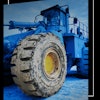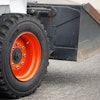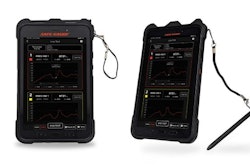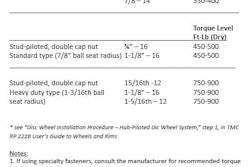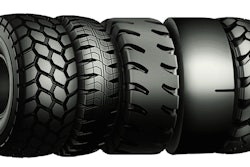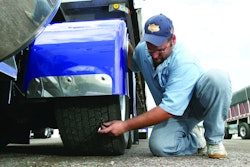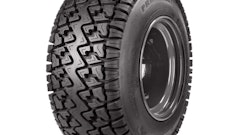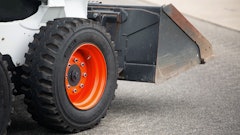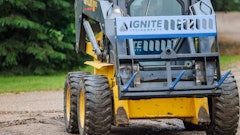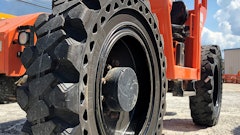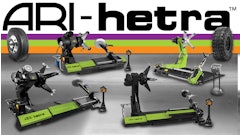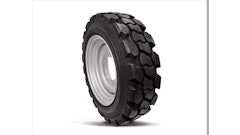It's hard to imagine many jobs as unpleasant as dealing with scrap tires. Most fleets store, pile or throw scrap tires somewhere behind the maintenance shop. The tires often settle in a low-lying area where they collect water, mold, mildew and, eventually, bugs (usually mosquitoes). Then, when the pile gets so big it can no longer be ignored, somebody makes a phone call and the tires are unceremoniously hauled way.
Instead of looking at the pile of tires as a nuisance to be discarded, consider the hidden treasure your company might be throwing away. In that pile of tires is knowledge. That smelly, dirty, bug-infested pile of scrap could tell you some good stories about what is right and, perhaps more importantly, what is wrong with your tire program.
The great news is that the first trip to the scrap pile for tire analysis is only the beginning. With the information you gather over time, you can start to see trends that can guide you in making choices about driver training or fleet maintenance procedures. Eventually, you'll see if those choices have a positive effect.
Collecting the Data
Going through a pile of scrap tires should not be a one-person job. It's easier to have at least one person to help move tires around and another to write and input tire data. The more tires there are to move, the more people you may want to recruit. The sales representative from your local tire dealer may agree to help you with this task.
Since tires can be dirty, particularly ones that have been sitting for some time, be sure everyone wears old clothes (coveralls are even better) and leather gloves to protect their hands against cuts and scrapes. Have at least one large awl available for digging into cuts, nail holes and loose belts. Other useful tools include long-nose pliers, flashlight, tire crayon and tread depth gauge. But before diving into the pile of tires, create a blank spreadsheet with the following headings:
- Tire Brand
- Type
- # RTs
- 2nds
- Last RT
- DOT/Date
- Reason
Start at the last column on the right of your spreadsheet and work left:
Reason: Briefly describe why the tire is sitting in the scrap pile. If a tire is worn evenly down to 2/32nds, has multiple retreads and has no holes in it, give it a pat on the tread. It made it. Here is a tire that fulfilled its early life promise to you: "Buy me, and I will deliver lots of original miles and many more as a retread, as a retread and again, as a retread."
But, just as there are many people in a big city with many stories to tell, you'll find some tires in your little village of tires with sad stories to tell. Determining just what those stories are can be a challenge for even the most seasoned tire professionals. The "Radial Tire Conditions Analysis Guide", available from the American Trucking Association's Technology and Maintenance Council, might be able to help. This book not only has great color photos of all kinds of tire conditions, it also lists the probable causes.
A few of those causes might stem from driver abuse, such as brake skids and sidewall curb damage, which can be great subjects to cover in your next driver meeting or training class. While it's a shame, it's possible you might see a brand new tire with a brake skid worn through all the belts and into or past the body ply of the tire. It happens.
Such wear conditions are best caught when the tire is still on the tractor or trailer, so a correction can be made immediately. But, even if they aren't discovered until the tire is in the scrap pile, other issues such as irregular tire wear can still offer glimpses into how well the shop is doing in maintaining proper vehicle alignment. Too many tires with big differences between the wear on one side of the tread and the wear on the other side indicates that alignment issues are not being addressed. And those differences may be a sign alignment checks need to be reviewed.
Last Retread DOT/Date: If retreading is part of your tire program (and it should be), you will be happy to see three or four retread and date codes branded onto the sidewall of your tires. Each time a retreader puts a new tread on one of your tires, a U.S. Department of Transportation assigned two-letter ID code and the week and year of the retreading is branded on the tire. So, if you find an issue with a repair or retread materials or workmanship, you can trace the problem back to the source.
32nds (tread depth): Ideally, tires in a scrap pile should be worn down to the tread depth that has been designated as the "pull" depths for steer, drive and trailer tires and the depth should be fairly consistent across and around the tire. Often, when some sort of irregular wear pattern has happened, tread depth measurements can be vastly different depending on where you measure. First, note this irregular wear, then measure the shallowest point in a "major tread groove" and record this as the tire's tread depth.
Recording the tread depth allows you to see trends among prematurely wearing tires. Over time, what you learn from scrap tire analysis should extend your tire mileage and the average tread depth of tires.
Number of Retreads (# RT's): For each tire you inspect, the number of retread codes tells you how many times the tire has been retreaded. Over the long term, you may find that some brands of tires or tire models within a particular brand lend themselves well to the retreading process since you get more retreads per casing. Gather lots of data before you draw conclusions.
New Tire Brand and Type: A scrap tire analysis should tell you what is working for you and what is not. Over time, with several scrap tire parties under your belt, your spreadsheet of scrap tire data might begin to show some definite trends. Over time you might discover that some tires can more consistently handle multiple retreadings. If that's the case, you may want to address these trends with your dealer or tire manufacturer rep.
The tires in your fleet are also valuable assets to your operation. Wrestling them around in a scrap pile is hard work but the information they can reveal could save you a lot of money in the long run. The stories told by the tires in the scrap pile will give you subject matter for future meetings with your shop technicians and drivers. A scrap pile analysis also gives you information for choosing tires with the proper tread designs and the right retreading methods for your fleet operation. It allows you to assess how well new tire developments work for your fleet operation. A good scrap tire analysis program can help you avoid past mistakes and can result in reducing future tire costs.

